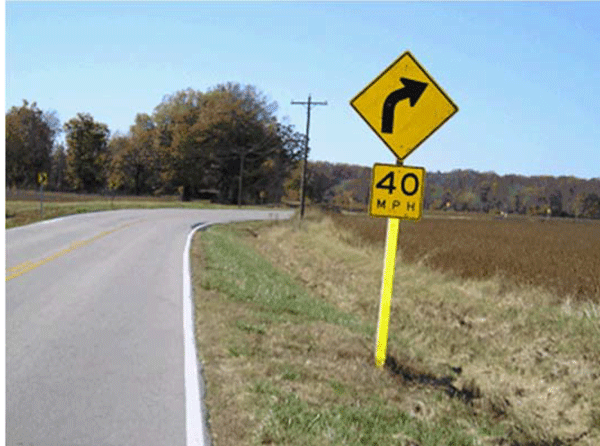U.S. Department of Transportation
Federal Highway Administration
1200 New Jersey Avenue, SE
Washington, DC 20590
202-366-4000
| < Previous | Table of Contents | Next > |
Horizontal curves are the primary location for roadway departure crashes in Missouri–accounting for approximately two-thirds of the run-off-road crashes in the State. The Missouri Department of Transportation (MoDOT) is responsible for over 33,000 centerline miles of roadways; and in an effort to address this problem, the agency proposed using a systemic safety approach to add an edge line to many of the two-lane rural roads in 2008. With approximately 18,000 miles of roadway on the Missouri State system that carry less than 1,000 vehicles daily, MoDOT was limited by budgetary restraints to restripe every mile. Therefore, MoDOT needed a way to prioritize the roads in need of improvement.
MoDOT chose to apply an edge line stripe to state-maintained roads with an Annual Average Daily Traffic (AADT) volume between 400 to 1,000 vehicles per day. Roads with an AADT greater than 1,000 vehicles per day were assumed to already have an edge line, while roads with an AADT less than 400 vehicles per day were assumed to only have a center line stripe (which is sufficient for a low volume road).

Figure C-1. Photo. Application of edge line at a horizontal curve.
Once MoDOT identified the treatment locations, they were able to move the process forward by first changing internal policy and receiving management approval. The next step was for individual districts to provide estimated initiation timelines and completion dates for the project. One district in particular was ambitious and completed their striping within one year.
All Missouri districts are now required to restripe every other year but are not required to take on additional miles below the 400 vehicles per day AADT threshold.
A simple before-after analysis of the locations treated with an edge line stripe showed a total of 576 crashes from 2006 to 2008–105 of which involved a fatality or severe injury. After edge lines were added to these roadways, the two-year after data (2010-2011) showed that total crashes decreased 43 percent to 327 crashes, and crashes involving a fatality or severe injury decreased 56 percent to 46 crashes. A more sophisticated empirical Bayes analysis found that the addition of edge lines reduced total crashes for all crash types by 15 percent. The analysis also revealed that the treatment reduced severe crashes by 19 percent. MoDOT utilized the Systemic Safety Project Selection Tool for the evaluation.
MoDOT has not received any negative feedback regarding the new edge lines from the general public or local agencies.
MoDOT recommends that agencies use a systemic approach to safety, especially with regards to edge lines. Since it is not feasible to stripe and maintain every road in the State, MoDOT suggests treating sites with higher volumes as those roads will have a greater probability of a crash occurring. The improvement process should be data-driven to ensure justification of location prioritization. The local county agencies would benefit from installing edge lines on their roadway system, even though they lack the data to properly identify the roads that may warrant the treatment.
John Miller from MoDOT provided the information for this case study. Visit http://www.modot.org/ for more information. All images are courtesy of MoDOT.
| < Previous | Table of Contents | Next > |
